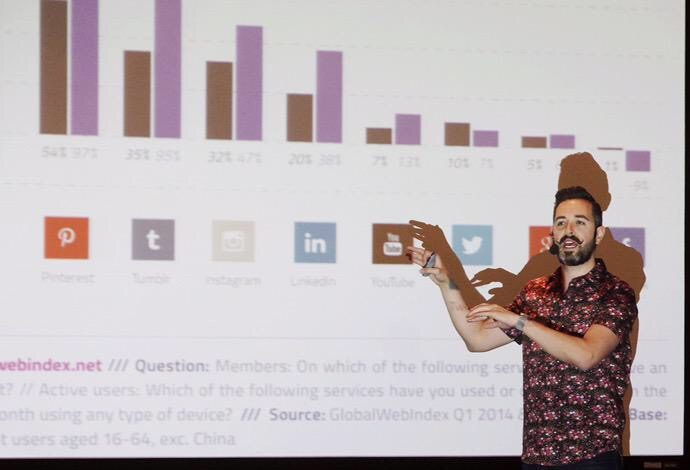Posts Tagged "Customer Engagement"
Articles
- Best Marketing Conference Sponsorship
- What Does it Mean to Be an Exhibitor at a Conference?
- What Is the Biggest Social Media Conference?
- What Is an Innovation Conference?
- What Is a Typical B2B Event?
- What Are the Cloud Technology Events in 2025?
- Marketing Event Volunteer Opportunities: A Comprehensive Guide
- Digital Marketing Event Volunteer Opportunities Near Me
- What Does a Volunteer Do at a Conference?
- Is DigiMarCon Worth It?
- Is DigiMarCon Good?
- What is the Biggest Marketing Forum?
- What are Digital Marketing Conferences?
- Marketing Conference Exhibiting: Your Guide to Success
- Digital Summit Comparison: A Closer Look at DigiMarCon
- Digital Marketing Conference
- Digital Marketing Events: Your Guide to Success in 2025
- Marketing Conferences: Unlocking Your Business Potential in 2025
- What Is The Future of Digital Marketing in 2030?
- B2B Event Marketing Strategy: Unlocking Success For Your Business
- Why B2B Event Marketing?
- What Should a B2B Marketing Strategy Include?
- Top Marketing Conferences for 2025
- What Is the Future of Marketing in 2025?
Digital Marketing Conferences
- NORTH AMERICA
- DigiMarCon Cruise
(New Orleans, LA, USA) - DigiMarCon West
(Los Angeles, CA, USA) - DigiMarCon Northwest
(Seattle, WA, USA) - DigiMarCon Canada West
(Vancouver, BC, USA) - DigiMarCon Canada
(Toronto, ON, Canada) - DigiMarCon Canada East
(Montreal, QC, Canada) - DigiMarCon Florida
(Orlando, FL, USA) - DigiMarCon Gulf Coast
(Houston, TX, USA) - DigiMarCon Southern California
(San Diego, CA, USA) - DigiMarCon Midwest
(Chicago, IL, USA) - DigiMarCon Mid-South
(Nashville, TN, USA) - DigiMarCon Great Lakes
(Detroit, MI, USA) - DigiMarCon North
(Minneapolis, MN, USA) - DigiMarCon Central
(Kansas City, MO, USA) - DigiMarCon Texas
(Dallas, TX, USA) - DigiMarCon New England
(Boston, MA, USA) - DigiMarCon Mid-Atlantic
(Philadelphia, PA, USA) - DigiMarCon South Florida
(Miami, FL, USA) - DigiMarCon Southeast
(Atlanta, GA, USA) - DigiMarCon Central Florida
(Tampa, FL, USA) - DigiMarCon East
(New York, NY, USA) - DigiMarCon South Atlantic
(Charlotte, NC, USA) - DigiMarCon America
(Washington, D.C. USA) - DigiMarCon Northern California
(San Francisco, CA, USA) - DigiMarCon Rocky Mountains
(Denver, CO, USA) - DigiMarCon South
(San Antonio, TX, USA) - DigiMarCon Silicon Valley
(San Jose, CA, USA) - DigiMarCon Orange County
(Anaheim, CA, USA) - DigiMarCon Southwest
(Phoenix, AZ, USA) - DigiMarCon World
(Las Vegas, NV, USA)
- DigiMarCon Cruise
- LATIN AMERICA
- EUROPE
- MIDDLE EAST
- AFRICA
- ASIA PACIFIC
- DigiMarCon Hawaii & Pacific
(Honolulu, HI, USA) - DigiMarCon Asia & Japan
(Tokyo, Japan) - DigiMarCon New Zealand
(Auckland, New Zealand) - DigiMarCon Australia
(Sydney, Australia) - DigiMarCon Oceania
(Melbourne, Australia) - DigiMarCon Southeast Asia
(Singapore) - DigiMarCon India
(New Delhi, India) - DigiMarCon North Asia & China
(Shanghai, China)
- DigiMarCon Hawaii & Pacific
- VIRTUAL
Digital Marketing Blog
- Unlock Website Traffic Growth: 10 Proven Hacks to Try September 16, 2025
- Sponsorship Opportunities at DigiMarCon 2025 – Join Us Now September 16, 2025
- Sponsorship Opportunities at DigiMarCon 2025 – Join Us Now September 16, 2025
- Mastering Video Marketing: Essential Tips to Boost Your Business September 15, 2025

































Social Commerce: Unlocking the Future of Online Sales
The digital marketplace is changing fast. Social media platforms are becoming key sales channels. More people are shopping online, and businesses are combining their e-commerce with social media.
This mix of online sales and social media has created a new way: social commerce. Businesses use social media’s interactive nature to offer unique shopping experiences. This approach boosts customer engagement and sales.
As e-commerce and social media merge, knowing about social commerce is key. It helps businesses stay competitive in the online sales world.
The Rise of Social Commerce in the Digital Marketplace
Social media and shopping are now closely linked. Social commerce is a big trend in online shopping. Social media platforms are now key parts of the online shopping journey.
Thanks to mobile tech, shopping online is easier than ever. People can go from looking at products on social media to buying them right away. This change is due to better mobile sites, safe payment options, and how people shop today.
From Browsing to Buying: The New Customer Journey
The way we shop online has changed. Now, we can find products, read reviews, and buy them all in one place. This makes shopping online better and easier.
Social commerce is growing fast. More companies are adding shopping features to their social media. As
, says an industry expert.
To make the most of this trend, businesses need to get social commerce. They should use social media to create fun shopping experiences. This can help sell more and keep customers coming back.
The Evolution of Online Shopping Experiences
The rise of mobile devices has changed online shopping a lot. Now, people can shop anywhere, anytime. This change is thanks to mobile technology, which makes it easy to buy things online.
How Mobile Technology Accelerated Social Commerce
Mobile technology has been key in making social commerce grow fast. Most people use social media on their phones. This lets businesses reach more people easily.
Now, people can shop online right from social media apps. This makes shopping online smoother and more fun. Businesses use mobile technology to sell more and keep customers happy.
Why Social Commerce Matters for Modern Businesses
Social commerce is changing how businesses talk to customers and sell products. Social commerce mixes social media and online shopping. It lets businesses show off their products right in social media.
This change is big for Generation Z and Millennials. They are tech-smart and often buy things because of social media.
Generation Z and Millennial Shopping Preferences
Generation Z and Millennials want shopping experiences that are personal and fun. They like finding new things on social media. There, they can talk to brands, read reviews, and see what others think.
To meet these needs, businesses need to use social commerce. They should make interesting content, work with influencers, and use social media’s interactive tools.
This way, businesses can get more people to know about them. They can also sell more and keep customers coming back, thanks to the younger crowd.
Major Social Commerce Platforms and Features
Online shopping is changing fast, thanks to major social commerce platforms. These platforms are changing how businesses work and how we shop online.
Facebook, Instagram, and Pinterest are leading the way. Each has special features that make shopping better. For example, Instagram’s Shopping lets businesses tag products in posts and stories. This makes it simple for customers to buy what they see.
Emerging Platforms to Watch
New platforms are also making waves. TikTok has started letting businesses sell products through the app. Snapchat is also getting better at shopping.
These new platforms offer exciting chances for businesses to connect with their audience. Keep an eye on them as they grow.
E-commerce Integration Strategies for Social Media
Businesses are now focusing on combining e-commerce with social media. This move helps them reach more people, improve customer service, and make online sales smoother.
To make e-commerce and social media work together well, there are a few important things to think about. These include inventory management and order fulfillment. Keeping inventory levels in sync across different platforms helps avoid selling out and reduces the chance of stockouts.
Inventory and Order Management Considerations
Handling inventory and orders well is key to a good e-commerce strategy. Businesses should use inventory management software that works with their social media. This keeps everything up to date and cuts down on mistakes.
By following these steps, businesses can make their e-commerce and social media work together better. This improves their online sales and helps them grow in the digital world.
Building Effective Social Media Shopping Experiences
The rise of social commerce has made it crucial for brands to focus on creating great social media shopping experiences. As more people use social media to find and buy products, businesses need to adapt. They must meet these changing expectations.
Creating a successful social media shopping experience starts with a mobile-first design approach. Most social media users access platforms on their phones. A mobile-first design makes sure the shopping experience works well on small screens and with touch.
Mobile-First Design Principles
Mobile-first design involves several key strategies:
By focusing on these elements, businesses can create a smooth and engaging customer experience. This drives conversions and builds brand loyalty. As social media evolves, delivering great shopping experiences will be key for brands to succeed.
By embracing mobile-first design and focusing on customer experience, businesses can fully tap into social media shopping. They can stay ahead in the fast-changing digital marketplace.
Leveraging Influencer Marketing for Social Selling
Influencer marketing is key in social selling, helping businesses reach their audience. By working with influencers, brands gain credibility and reach. This boosts sales and awareness.
The success of influencer marketing depends on the influencer type. This is where micro and macro influencers play a big role.
Micro vs. Macro Influencer Strategies
Micro influencers have 1,000 to 100,000 followers. They offer a dedicated audience and focus on specific topics. They’re perfect for targeting certain groups or promoting unique products.
Macro influencers have millions of followers. They’re great for big brand campaigns. They help spread the word and drive lots of traffic to products or services.
Choosing between micro and macro influencers depends on goals, audience, and budget. A mix of both can be the best strategy. It helps brands reach both specific and wide audiences.
The key to influencer marketing success is picking the right influencers and creating engaging content. This way, businesses can maximize influencer marketing’s potential. They can drive sales and growth in the social commerce world.
Customer Engagement Tactics in Social Commerce
Social commerce is growing fast, and good customer engagement is key. It helps drive sales, build loyalty, and make shopping memorable.
Real-time engagement and live shopping events are big in this area. They let brands talk directly to their audience. Live shopping, for example, lets customers ask questions and get answers right away.
Real-Time Engagement and Live Shopping Events
Real-time engagement means talking to customers on social media right when they want to. Brands can use live streams to show off products and share behind-the-scenes stuff. A social media expert says, “Live shopping is changing how brands connect with people, making shopping more fun and interactive.“
To get the most out of these methods, brands should make their content engaging. They should also use influencers and share content made by their customers. This way, they can give customers a more engaging and fun shopping experience.
Digital Marketing Platforms for Social Commerce Success
In today’s digital world, choosing the right platforms is key for social commerce success. Businesses aim to make the most of social media. Digital marketing platforms help them plan and improve their online sales.
These platforms bring together different marketing tools and channels. This gives a clear view of how customers interact with them. It helps create campaigns that speak to their audience, boosting engagement and sales. Plus, advanced analytics let businesses check how well their campaigns are doing in real-time.
Analytics and Performance Measurement
Good analytics and performance measurement are vital for social commerce success. By watching things like click-through rates and conversion rates, businesses learn what works. This knowledge helps them make better marketing choices.
To get the most out of digital marketing platforms, businesses need to focus on performance measurement. This means looking at how well each campaign does and its overall effect on social commerce goals. This way, they can spot what needs work and use their resources better, leading to social commerce success.
Case Studies: Digital Retailing Transformations
The rise of social commerce has changed digital retailing a lot. Many businesses have seen great success. Companies like Sephora and Nike have led this change. They use social commerce to better engage with customers and boost sales.
Sephora uses Instagram to show off products and give tutorials. This has raised brand awareness and increased website traffic and sales. Nike also uses social media to introduce new products. This creates a community among its customers.
Lessons Learned and Best Practices
Looking at these examples, we learn important lessons. Personalization is key. Businesses should use data to know what customers like and market to them that way.
Another important practice is to make shopping easy across all platforms. This means combining e-commerce with social media. It lets customers buy products right from their favorite platforms.
By following these strategies, businesses can change their digital retailing for the better. This helps them grow and stay ahead in a fast-changing market.
Overcoming Challenges in the Social Commerce Landscape
Social commerce is promising but faces challenges like security and trust. Businesses must tackle these issues to succeed.
Security and Trust-Building Measures
To tackle these challenges, businesses can take several steps:
Trust-building is also key. It can be done by:
By focusing on these areas, businesses can overcome social commerce challenges. This helps build trust and drives success in social commerce.
Conclusion
As the digital world keeps changing, businesses must keep up to stay ahead. Social Commerce is key for online sales, helping brands connect with customers and boost sales.
Using big social commerce sites, combining e-commerce plans, and creating great shopping experiences online are all important. Influencers and keeping customers engaged are also vital for success in social commerce.
To lead in the digital market, businesses should focus on Digital Marketing. This helps grow online sales. By using social commerce and staying updated, companies can improve their online image and succeed in the long run.
FAQ
What is social commerce, and how does it differ from traditional e-commerce?
Social commerce uses social media to sell products or services. It’s different from traditional e-commerce because it focuses on social interactions. This makes online shopping more engaging.
How can businesses effectively integrate e-commerce into their social media strategies?
Businesses should aim for a smooth shopping experience on social media. Use high-quality images and work with influencers. This boosts engagement and sales.
What are some key considerations for inventory and order management in social commerce?
Managing inventory and orders well is crucial. Make sure products are available and orders are fulfilled quickly. Use systems that connect with social media to avoid overselling.
How can businesses measure the success of their social commerce initiatives?
Track important metrics like conversion rates and customer costs. Use analytics from digital marketing platforms to see how you’re doing.
What role does influencer marketing play in social selling, and how can businesses leverage it effectively?
Influencer marketing helps reach your audience through trusted voices. Find the right influencers, create engaging content, and monitor your campaigns’ success.
What are some best practices for building effective social media shopping experiences?
Use mobile-friendly designs and create engaging content. Use user-generated content and make checkout easy. This boosts conversions.
How can businesses overcome security and trust-building challenges in social commerce?
Use strong security like encryption and clear data practices. Be open about how you use data. Good customer service builds trust.
What are some emerging trends and platforms that businesses should be aware of in social commerce?
Watch for live shopping events and TikTok’s growth. Augmented reality (AR) and virtual try-ons are also key. They improve the online shopping experience.
Leverage User-Generated Content for Business Growth
In today’s digital world, businesses are always looking for new ways to grow and connect with their audience. One great way is using User-Generated Content (UGC). This approach helps make a brand seem more real and trustworthy, building strong customer loyalty.
UGC boosts a brand’s trustworthiness and offers social proof. This proof can sway people to buy, helping your business grow. As we dive into UGC’s benefits, it’s clear it’s more than just a trend. It’s a key part of a winning digital marketing plan.
Key Takeaways
Understanding the Power of User-Generated Content
User-generated content (UGC) is a powerful tool for businesses. It lets them use content made by customers to grow and engage. This includes online reviews, customer feedback, and social media posts. Together, they make a brand more real and interesting.
UGC greatly affects how people shop. People often check what others say before buying. This makes UGC a kind of social proof, building trust and credibility. For example, a study showed that people trust brands more when they see lots of UGC.
UGC also gets customers involved in the brand story. When people share their experiences or make content about a brand, they feel more connected. This creates a community and gives businesses useful insights into what customers like.
Also, UGC helps a brand be seen more online. Social media posts can spread a brand’s message far and wide. This kind of marketing is cheap but very good at getting people to notice and engage with a brand.
In short, knowing how to use UGC is key for businesses to keep up in today’s digital world. By using customer feedback and encouraging UGC, businesses can gain trust, boost engagement, and grow.
Types of User-Generated Content That Drive Business Results
User-generated content is powerful because it comes in many forms. This includes reviews, testimonials, and content from communities. Businesses can use this variety to improve their marketing and connect better with their audience.
Leveraging Review Platforms
Review platforms are key for user-generated content. Encouraging customers to leave reviews on sites like Google My Business or Yelp can really help a company’s image. A study showed that businesses with good reviews get more new customers.
To make the most of review platforms, businesses should:
Testimonials are also very effective. Showing customer testimonials on websites or in ads can build trust with new customers. Here are some tips to make testimonials work:
By using these types of user-generated content, businesses can make their brand more engaging and trustworthy. This leads to better results through community content, peer recommendations, and crowdsourced content.
The Business Benefits of User-Generated Content
User-generated content (UGC) offers many benefits to businesses. It boosts customer engagement and improves brand credibility. By using UGC, companies can tap into the trust and authenticity that comes from customer-created content.
One key advantage of UGC is it builds trust with potential customers. Seeing real people recommend a product or service makes it more believable. This social proof helps increase conversion rates.
Customer Feedback is another big plus of UGC. It lets businesses learn from their customers. This feedback helps improve products, address concerns, and boost satisfaction.
UGC is also a cost-effective marketing strategy. It saves money by using customer content instead of professional content. This approach cuts marketing costs and offers a good return on investment.
UGC also boosts customer engagement. When customers see their content on a brand’s site, they’re more likely to stay engaged. This can create a loyal community of brand supporters.
To get the most from UGC, businesses should create campaigns that encourage and reward customer participation. This way, they can fully use UGC to grow their business.
Strategies for Encouraging Customer-Created Content
Businesses can tap into the power of customer-created content by using the right strategies. They need to know what drives customers to contribute. And they must create an environment that encourages them to do so.
Setting Clear Campaign Objectives
To get customers to create content, businesses must first set clear goals for their campaigns. These goals could be to boost brand awareness through Social Media Posts, get more leads, or increase sales. By setting specific, measurable goals, businesses can focus their strategies to meet these objectives.
Having clear goals also helps in creating a campaign that really speaks to the target audience. For example, a campaign focused on Community Content might ask customers to share their experiences with a product or service. This builds a sense of belonging and loyalty among customers.
Creating Compelling Participation Hooks
Participation hooks are the incentives or motivators that get customers to create and share content. These can be contests, giveaways, or recognition on social media. The goal is to create a hook that appeals to the target audience and fits with the campaign’s goals.
For instance, a business might start a Crowdsourced Content campaign by asking customers for ideas for a new product feature. This not only creates engaging content but also gives valuable insights into what customers want.
By combining clear goals with compelling participation hooks, businesses can craft a strong strategy for customer-created content. This approach boosts engagement and builds a sense of community and loyalty among customers.
The success of these campaigns depends on inspiring and motivating customers. By understanding their needs and preferences, businesses can create campaigns that are both effective and engaging.
Integrating User-Generated Content Across Marketing Channels
The power of UGC is in its ability to reach more people through different marketing channels. This makes it more impactful. Businesses use user-generated content in emails, social media, and websites to engage customers better and boost sales.
Email marketing is a great place to use UGC. Adding customer feedback or photos to newsletters makes the content more personal. For example, a clothing store could show photos of customers wearing their clothes, making it more relatable.
Social media is perfect for building a community and getting people to interact. Brands can start campaigns that ask users to share their experiences or photos. A travel company might ask users to post their travel photos on Instagram with a certain hashtag.
Websites also benefit from UGC, like online reviews. Showing customer reviews on product pages makes the brand more trustworthy. Businesses can also have special sections for user-generated content, like customer stories.
To use UGC well, businesses should:
By using UGC in many marketing channels, businesses can tell a stronger brand story. This can lead to more loyal customers and growth.
Legal Considerations and Best Practices for UGC
Businesses need to know the legal sides of user-generated content (UGC) to use it well. UGC adds realness and connection that ads can’t. It’s key for marketing.
Legal Considerations are important for UGC. Companies must deal with copyright and privacy issues to stay safe. Getting the right permissions from creators is essential.
Following Best Practices helps manage UGC risks. This means having clear rules, guiding users, and being open about UGC use. It’s also good to track permissions.
Knowing the law and following best practices helps businesses use UGC safely. This approach keeps the company safe and builds trust with customers.
Measuring the Impact of User-Generated Content
Understanding the right metrics is key to unlocking UGC’s full potential. As businesses use UGC for growth, measuring its impact is crucial.
Why Measure UGC? Measuring UGC shows how well it engages audiences and drives conversions. By analyzing the right metrics, companies can improve their UGC strategies to get better ROI.
Engagement Metrics
Engagement metrics show how audiences interact with UGC. Key metrics include:
These metrics help businesses see how well their UGC campaigns are doing. For example, many shares on social media mean the content is hitting the mark.
Conversion metrics are key to understanding UGC’s direct impact on business outcomes. These include:
By tracking these metrics, businesses can see how much revenue comes from UGC. This makes a strong case for investing more in UGC strategies.
In conclusion, measuring UGC’s impact through engagement and conversion metrics is vital. By knowing what works, companies can improve their UGC strategies. This maximizes the benefits of UGC.
Success Stories: Brands Winning With User-Generated Content
Companies have found a way to connect with people through User-Generated Content (UGC). This method lets businesses use Peer Recommendations to build trust and get people involved.
Many brands have seen great success with UGC. For example, a well-known outdoor clothing company asked customers to post photos of themselves wearing their clothes on social media. They used a special hashtag for it. This not only brought in lots of Crowdsourced Content but also helped them reach more people.
These strategies have led to big wins for brands. They’ve seen more people know about their brand, customers sticking around longer, and better products. By looking at these success stories, businesses can learn how to use UGC well in their marketing.
The power of UGC is clear in the success of brands that use it. As more companies see its value, we’ll see even more creative ways to use it in marketing.
Conclusion: Future-Proofing Your Business with UGC
The digital world is always changing, and businesses need to keep up. User-Generated Content (UGC) is a key tool for growth. It helps businesses build a loyal community and stay relevant.
Using UGC means more than just using customer content. It’s about building a strong marketing plan. This plan helps your business thrive, even when the digital world changes.
Adding UGC to your marketing can make your strategy strong and flexible. As the marketing world keeps evolving, UGC will remain important. Businesses that use UGC wisely will likely succeed in the long run.
FAQ
What is User-Generated Content (UGC) and how does it differ from other marketing content?
User-Generated Content is made and shared by people, not brands. It includes social media posts, reviews, and testimonials. Unlike other marketing, UGC is real and trustworthy because it comes from customers.
How can businesses encourage customers to create User-Generated Content?
To get UGC, businesses should have clear goals and make it fun to participate. They can also use review sites and talk to customers on social media. Offering rewards for sharing experiences helps too.
What are the benefits of using User-Generated Content in marketing campaigns?
UGC boosts trust and engagement. It’s also a cost-effective way to market. Plus, it helps build a loyal community around your brand.
How can businesses measure the impact of User-Generated Content?
Track likes, shares, and comments to see how UGC performs. Also, look at sales and website visits. Use analytics to fine-tune your UGC strategy.
What are the legal considerations associated with using User-Generated Content?
Be mindful of copyright and privacy laws when using UGC. Always get permission and follow guidelines. This keeps your brand safe and respectful.
How can businesses integrate User-Generated Content across different marketing channels?
Use UGC in emails, social media, and websites. Share testimonials and social media posts. This creates a unified and engaging brand experience.
What are some best practices for managing User-Generated Content?
Have clear rules and get permission for UGC. Monitor it for quality and consistency. Also, have a plan for handling negative content.
Can User-Generated Content be used for Community Content and Crowdsourced Content initiatives?
Yes, UGC is key for building brand communities. It encourages engagement and creativity from customers. This helps your brand grow and thrive.
How can businesses leverage Peer Recommendations through User-Generated Content?
Use customer testimonials and reviews to build trust. Encourage sharing and offer rewards for referrals. This boosts your brand’s credibility and appeal.
Shopper Marketing: Elevate Your Retail Experience
In today’s competitive retail world, creating engaging experiences for customers is key. Shopper Marketing is a vital part of retail marketing. It focuses on understanding what customers do and want at the point of sale.
By using data-driven insights and personalized marketing strategies, retailers can boost sales and loyalty. This helps to make the shopping experience better for everyone.
Key Takeaways
The Evolution of Shopper Marketing in Retail
The world of shopper marketing in retail has changed a lot. It’s all about keeping up with what shoppers want. Today, retailers need to use data and insights to make their marketing better.
Recently, the retail world has moved towards omnichannel retailing. This means shoppers can easily move between online and offline stores. Retailers now focus on making their marketing work across all these places.
Knowing what shoppers like is key to good shopper marketing. By looking at what shoppers prefer and how they shop, retailers can make ads that really speak to them. This way, they can use their marketing dollars better, get more customers involved, and boost sales.
As retail keeps changing, shopper marketing will become even more crucial. By keeping an eye on what shoppers want and using new tech, retailers can make shopping experiences that keep customers coming back.
Understanding Consumer Behavior in the Shopping Environment
The shopping environment is complex. Consumer behavior is shaped by many factors. Retailers need to grasp these to craft marketing strategies that boost engagement and sales.
In-store promotions, digital touchpoints, and the overall shopping experience are key. For example, a good store layout can improve the shopping experience. But a bad one can scare customers away.
Customer Journey Mapping is vital for understanding consumer behavior. It helps retailers spot areas for improvement and moments that sway buying decisions.
Good customer journey mapping uses data from all touchpoints. It gives a full picture of the customer’s journey. This lets retailers fine-tune their marketing to match customer needs at every step.
By getting consumer behavior and using customer journey mapping, retailers can offer a more personal and engaging shopping experience. This can lead to more sales and loyal customers.
Customer Journey Mapping for Retail Success
Customer journey mapping is key for retailers wanting to improve customer experience and build loyalty. It helps them understand how customers interact before buying. This way, they can make strategies that better engage their audience.
Understanding the Customer Journey means looking at every interaction a customer has with a brand. This includes from first seeing the brand to getting help after buying. It helps retailers find what makes customers happy and what they can improve.
Good customer journey mapping lets retailers create immersive brand experiences that connect with their audience. By making their marketing fit the customer’s needs at each step, they can boost brand activation and sales.
By focusing on the customer through journey mapping, retailers can strengthen their bond with customers. This leads to more loyalty and success in retail.
In-Store Promotion Strategies That Drive Conversion
Effective in-store promotions are key to boosting sales. By using smart in-store promotion tactics, stores can sway shoppers’ choices at the checkout.
Eye-catching displays are a top strategy. They draw attention and highlight a product’s value. For example, creative signage and attractive product arrangements can greatly impact how shoppers see products.
Point of Purchase displays are vital for sales. They’re near checkout counters, aiming to prompt impulse buys. Placing popular or related items here can raise average sales and please customers.
Limited-time offers also work well. They create urgency, pushing shoppers to buy now. This can be through time-limited discounts, special bundles, or exclusive deals for loyalty members.
To make in-store promotion strategies better, follow these tips:
By combining these strategies and focusing on Point of Purchase optimization, stores can create a compelling shopping experience. This drives conversion and boosts sales.
Brand Activation: Creating Immersive Retail Experiences
Retailers are now focusing onbrand activationto make shopping experiences memorable. They aim to create lasting connections with their customers. This approach brings a brand to life, making a strong impression.
Brand activation means making experiences that customers will remember. Retailers use different ways to do this, like:
These experiences not only draw in customers but also make them loyal. Goodbrand activation needs to know what the audience likes.
To make brand activation work, retailers should aim for experiences that are unforgettable and easy to share. Using technology like augmented reality (AR) or virtual reality (VR) can help make these experiences more immersive.
Key Strategies for Effective Brand Activation
By usingbrand activation, retailers can make experiences that build loyalty and advocacy. This helps the brand grow and succeed.
Point of Purchase Optimization for Increased Sales
The point of purchase is key in retail. It’s where smart strategies can boost sales a lot. Retailers can sway what customers buy and get more sales here.
To make the most of this spot, retailers use tech and smart plans. They focus on Interactive Kiosks, Digital Signage, and Mobile Integration to make shopping better.
Interactive Kiosks
Interactive kiosks give shoppers a deep dive into products. They can read reviews and make smart choices. Placing them near where people buy helps engage more customers and sell more.
Digital Signage
Digital signs grab shoppers’ attention at the point of purchase. They show off products, offer deals, and guide shoppers. This makes shopping better and boosts sales by showing off the best deals.
Mobile Integration
Mobile use is key for a smooth shopping experience. It lets shoppers check prices, find items, and get special deals. This makes shopping online and in-store feel connected, making customers happier and more loyal.
For the best results, retailers need a strong omnichannel strategy. This means all shopping experiences, online and in-store, work together. It gives customers a consistent, enjoyable experience that boosts sales and loyalty.
In short, using interactive kiosks, digital signs, and mobile tech is vital for retailers. It helps increase sales and improve customer experience. By combining these with a solid omnichannel plan, retailers can offer a seamless shopping journey that keeps customers coming back.
Implementing an Effective Omnichannel Strategy
The key to keeping customers loyal is a strong omnichannel strategy. Today, shoppers want a smooth experience online and in stores. Retailers must link their channels for a unified brand feel.
An omnichannel strategy has several important parts. Inventory management is key. Stores need to track stock across all platforms, so shoppers can see what’s available online or in-store. This is done with advanced systems that update stock in real-time.
Customer service is also vital. Stores should offer top-notch service everywhere. This means having support options like phone, email, and live chat online or on apps. Training staff well helps improve the shopping experience.
Using data analytics helps too. It lets stores understand how customers behave on different platforms. This way, they can make their marketing better and engage more with customers.
For a good omnichannel strategy, marketing must be the same everywhere. Stores should use digital marketing, social media, and in-store promotions. This makes the brand message clear and strong.
By following these steps, stores can offer a great shopping experience. This builds loyalty and advocacy. As retail changes, having a good omnichannel strategy is key to success.
Measuring and Optimizing Shopper Marketing ROI
The success of shopper marketing depends on knowing its ROI. Retailers need to use several metrics to see how well their campaigns work.
Sales lift is a key metric. It shows how much more sales a campaign brings in. By comparing sales before and during the campaign, retailers can see its impact.
Customer engagement is also crucial. It includes social media, in-store visits, and loyalty program use. By looking at these, retailers can understand what customers like.
Key Metrics for Measuring Shopper Marketing ROI
To boost shopper marketing ROI, retailers must try new things and change their plans based on data. They might test different offers, change when and where ads run, or focus on specific groups.
By always checking and improving their shopper marketing, retailers can grow their business. They can also make customers happier and stay competitive in the changing retail world.
Conclusion: The Future of Retail Through Shopper Marketing
The retail world is changing fast, thanks to new tech and how people shop. Shopper marketing is key to keeping customers interested and buying more.
For retailers to succeed today, they need good shopper marketing plans. They must know what customers want, make shopping easy, and offer unique experiences. This way, they can grow their business and beat the competition.
The future of shopping will mix online and offline in a way that feels personal. Shopper marketing will help make this happen. It will help retailers reach out to customers everywhere and keep them coming back.
By using shopper marketing and keeping up with new trends, retailers can thrive in a world that’s always changing.
FAQ
What is shopper marketing, and how does it differ from traditional retail marketing?
Shopper marketing focuses on understanding what shoppers do and think at the point of sale. It’s different from traditional marketing because it’s more specific and aims to enhance the shopping experience.
How can retailers use customer journey mapping to improve their shopper marketing efforts?
Customer journey mapping helps retailers see where customers touch their brand before buying. This lets them spot areas to get better and plan marketing that really connects with shoppers.
What are some effective in-store promotion strategies that drive conversion?
Good in-store tactics include eye-catching displays and special deals. Interactive experiences and point of purchase displays also help boost sales.
How can retailers optimize their point of purchase to increase sales?
Retailers can make their point of purchase better by adding interactive kiosks and digital signs. Mobile integration helps too. This makes shopping smoother and more engaging.
What is the role of omnichannel strategy in shopper marketing?
An omnichannel strategy makes shopping online and offline feel like one experience. This builds loyalty and gets customers talking about the brand.
How can retailers measure the ROI of their shopper marketing efforts?
Retailers can track sales, customer interaction, and conversion rates to see how shopper marketing works. This helps them make their strategies better and grow their business.
What is the future of retail through shopper marketing?
The future of retail is about creating experiences that really grab customers’ attention. As shopping changes, retailers need to keep up with shopper marketing to stay ahead and grow.
Conversational Marketing: The Future of Customer Engagement
The way businesses talk to customers is changing a lot. Conversational Marketing is leading this change, making how brands connect with people better.
Now, businesses can have personalized, real-time talks with customers. This makes their interactions more meaningful. It also helps build loyalty and boosts sales.
Key Takeaways
What is Conversational Marketing?
Conversational Marketing is a big change in how companies talk to people. It’s all about having a real conversation, not just talking at people. This makes talking to customers more personal and quick.
Definition and Core Principles
At its heart, Conversational Marketing is about talking back and forth between companies and customers. It’s all about real-time engagement and putting the customer first.
Real-Time Engagement
Being able to talk back right away is key in Conversational Marketing. It helps build trust and makes customers happier.
Customer-Centric Approach
This approach makes sure the talk is all about what the customer wants. It makes the conversation more interesting and relevant.
How It Differs from Traditional Marketing
Conversational Marketing is a big move from old ways of marketing. It changes from just talking to actually having a conversation. And it changes what customers expect.
From Broadcasts to Dialogues
Unlike old marketing, which was one-way, Conversational Marketing is a two-way street. It makes talking more fun and interactive.
Shift in Customer Expectations
Now, customers want talks that are personal and quick. Conversational Marketing gives them real-time messaging and journeys that fit them.
By using Conversational Marketing, companies can make deeper connections with their customers. This leads to more engagement and loyalty.
The Evolution of Customer Engagement
Customer engagement has changed a lot. It moved from broad marketing to personal talks. This change comes from history and new tech.
From Mass Marketing to Personalized Conversations
Historical Context
Old marketing aimed at many with one message. But, it missed the personal touch. This led to a gap between companies and their customers.
Technology-Driven Changes
New digital tools have helped in targeting better. Data analytics and AI help understand what customers like. This makes marketing more personal.
The Digital Transformation of Customer Interactions
Mobile-First Communication
Mobile devices have changed how we talk to customers. Now, businesses focus on mobile-friendly sites and responsive design. This makes interactions smooth.
Omnichannel Expectations
Customers want a consistent experience everywhere. This includes social media, email, phone, and in-store. Meeting these omnichannel expectations keeps customers happy and loyal.
Key Components of Conversational Marketing
The way we talk to customers has changed a lot. Conversational marketing is all about making these interactions better. It uses key parts to make sure every chat is personal and smooth.
Real-Time Messaging
Real-time messaging is key in conversational marketing. It lets businesses talk to customers right away. This part has two main things:
Instant Response Capabilities
Being able to answer quickly is very important in conversational marketing. It makes sure customers get help fast, which makes them happier and more engaged.
24/7 Availability
Being open 24/7 through real-time messaging is great. It lets customers talk to businesses anytime. This makes their experience better and helps them feel closer to the brand.
Intelligent Chatbots
Intelligent chatbots are very important too. They use AI to understand and answer customer questions well. Chatbots can be simple or very smart, depending on how they’re made.
Rule-Based vs. AI-Powered Solutions
Rule-based chatbots follow set rules to answer. But AI-powered chatbots learn and change to fit what customers say. This makes their experience more personal and fun.
Conversation Flow Design
Creating a good conversation flow is key for chatbots. It’s about making a chat that makes sense and helps the customer. It should guide them smoothly through their visit.
Personalized Customer Journeys
Personalized customer journeys are the core of conversational marketing. They make sure each customer gets a visit that fits them perfectly.
Data-Driven Personalization
Using customer data helps make visits more special. This data-driven personalization makes chats more interesting and relevant for the customer.
Context Awareness
Context awareness is very important for personal visits. It’s about knowing what the customer is doing right then. This helps give answers that are just right for them.
The Power of Conversational AI
Conversational AI is changing how we talk to customers. It makes interactions more natural and helpful. This change comes from big steps forward in several areas.
Natural Language Processing Advancements
Conversational AI’s strength is in its Natural Language Processing (NLP). NLP lets chatbots and virtual assistants get what we mean. This makes talking to them feel more like talking to a person.
Understanding Customer Intent
AI can figure out what customers really want. It does this by looking at the whole message, not just the words. This means it can give answers that are right on point.
Handling Complex Queries
AI can handle tough questions and multi-step requests. This makes it easy for customers to get help. It’s great for businesses that want to support their customers fully.
Machine Learning and Adaptive Responses
Machine Learning (ML) is key to Conversational AI. It lets systems learn from talking to people and get better at answering.
Learning from Interactions
AI gets smarter over time by learning from past talks. This helps it give better answers in the future. It makes talking to AI a better experience.
Continuous Improvement
AI keeps getting better as it talks to more people. It gets better at understanding what customers need and want.
Sentiment Analysis and Emotional Intelligence
AI also knows how to read emotions. It uses sentiment analysis and emotional intelligence to understand and respond to feelings.
Detecting Customer Mood
AI can tell how customers are feeling by looking at what they say and how they say it. This lets AI respond in a way that feels more caring.
Appropriate Response Calibration
Then, AI adjusts its answers to match the customer’s mood. This makes the conversation feel more personal and supportive.
These technologies make Conversational AI a powerful tool for businesses. By using NLP, ML, and understanding emotions, companies can have better conversations with their customers.
Implementing Conversational Marketing Strategies
To start conversational marketing, businesses need a solid plan. This plan should match their goals for engaging with customers. It’s important to know what customers want and how they behave to tailor marketing efforts.
Developing a Conversational Framework
Creating a conversational framework is key. It’s the base for all interactions with customers. This ensures that every touchpoint feels connected and consistent.
Mapping Customer Touchpoints
It’s vital to map where and how customers interact with the brand. This includes websites, social media, and more. The goal is to make every interaction smooth and seamless.
Creating Conversation Flows
Designing the dialogue between customers and the brand is crucial. It needs to be based on understanding what customers want and need. The brand must respond in a way that feels personal and relevant.
Choosing the Right Platforms and Tools
Picking the right tools is essential for effective conversational marketing. This includes messaging platforms, chatbots, and more. These tools help make customer interactions personal and effective.
Website Integration Options
Adding conversational marketing tools to websites is important. This can include chatbots and live chat. These features allow for real-time engagement with customers.
Social Media Messaging Platforms
Social media platforms are great for conversational marketing. They let businesses talk to customers in real-time. This helps with support, inquiries, and building brand awareness.
Integration with Existing Marketing Channels
Conversational marketing works best when it’s part of a bigger marketing plan. This means connecting it with CRM systems, email platforms, and more. It helps make marketing efforts more cohesive.
CRM Connection
Linking conversational marketing with CRM systems is beneficial. It gives businesses access to customer data. This leads to more personalized experiences, which can boost satisfaction and loyalty.
Email Marketing Synergy
Combining conversational marketing with email marketing is smart. It makes marketing more effective and cohesive. This approach can improve how well customers engage and convert.
Chatbots: The Frontline of Conversational Marketing
Chatbots are changing how we talk to customers. They are key in making marketing more personal and effective.
Types of Chatbots for Different Business Needs
There are many chatbots for different business needs. Customer Service Bots help with customer questions and support. Lead Generation Bots collect information from potential customers to help sales teams.
Customer Service Bots
These bots solve customer problems and answer common questions. They make customers happier and help businesses respond faster.
Lead Generation Bots
Lead generation bots talk to potential customers. They help qualify leads and pass them to sales teams for more work.
Designing Effective Chatbot Conversations
Creating great chatbot conversations needs personality development and conversation branching. A good chatbot should match the brand’s voice and tone.
Personality Development
Creating a chatbot’s personality means making it relatable to the audience. This makes talking to the chatbot more fun and engaging.
Conversation Branching
Conversation branching lets chatbots change their answers based on what users say. This makes conversations more personal and interesting.
Measuring Chatbot Performance
How well a chatbot does is measured in different ways. This includes engagement metrics and resolution rates.
Engagement Metrics
Engagement metrics show how users interact with chatbots. This includes how many conversations start and how long they last.
Resolution Rates
Resolution rates show how often chatbots solve customer problems on their own. This means customers don’t always need to talk to a human.
Creating Conversational User Experiences (UX)
Conversational User Experience (UX) is changing how businesses talk to customers. It makes interactions more natural and personal. This leads to better experiences for everyone.
Designing for Dialogue Rather Than Monologue
Good conversational UX means moving from one-way talks to real conversations. It’s about understanding what the user wants and answering them right.
Conversational Interface Principles
Key principles include being clear, brief, and understanding the context. Interfaces should get and answer user inputs in a way that feels natural.
User Flow Optimization
Improving user flow means making conversations smooth and goal-focused. This is done through smart routing and flexible responses.
Balancing Automation with Human Touch
Automation is important for growing, but human interaction is key for complex or emotional talks. Finding the right mix is essential.
Handoff Protocols
Clear handoff protocols are important. They make sure humans can take over when automation can’t.
Escalation Strategies
Good escalation strategies are key for solving tough problems. They help figure out when and how to escalate issues.
Accessibility Considerations in Conversational Interfaces
Accessibility is vital for making conversational UX for everyone. It means designing interfaces that work for all, no matter their abilities.
Inclusive Design Practices
Inclusive design looks at a wide range of user needs and abilities. It includes designing for people with disabilities and those in different situations.
Alternative Interaction Methods
Offering different ways to interact, like voice or text, makes things more accessible and enjoyable.
Measuring Success in Conversational Marketing
Conversational marketing shines when its success is clear and can be acted upon. Businesses need to track several important areas to see if their strategies work.
Key Performance Indicators
Businesses use key performance indicators (KPIs) to understand how well they connect with customers.
Conversation Completion Rates
One key KPI is the conversation completion rate. It shows how often chats finish without needing a human.
Response Time Metrics
How fast a business answers customer questions is also crucial. It affects how happy customers are.
Conversion Rate Optimization
Improving conversion rates is key to measuring success in conversational marketing. This means turning chats into sales.
Qualifying Leads Through Conversation
Good conversations help businesses find the best leads. This means sales teams can focus on the most promising prospects.
Sales Attribution Models
Using sales attribution models helps businesses see how chats help their sales. This leads to smarter decisions.
Customer Satisfaction Metrics
Metrics like CSAT and NPS show how happy customers are. They help businesses understand and improve customer loyalty.
CSAT and NPS Integration
Adding CSAT and NPS to marketing strategies helps businesses know how to make customers happier.
Qualitative Feedback Analysis
Looking at what customers say in detail helps businesses understand what customers want. This makes marketing better.
By tracking these metrics and improving their marketing, businesses can better engage with customers. This leads to more conversational sales.
Case Studies: Successful Conversational Marketing Campaigns
Real-world examples show how effective conversational marketing can be. Many businesses have used it to improve customer interaction and boost sales.
B2C Success Stories
In the B2C world, conversational marketing shines. Brands have used chatbots and messaging to offer personalized experiences.
Retail and E-commerce Examples
An e-commerce giant saw a 30% increase in sales with a chatbot. It suggested products based on what customers looked at.
A retail brand also used AI to give personalized discounts. This led to a big jump in customer loyalty.
Service Industry Applications
A service company improved its customer service with conversational marketing. A chatbot cut response times by 50%, making customers happier.
B2B Applications
Conversational marketing works well in B2B too. It helps qualify leads better.
Lead Qualification Processes
A B2B company’s AI tool boosted qualified leads by 40%. It asked the right questions to understand clients’ needs.
Account-Based Marketing Integration
Another B2B business combined conversational marketing with ABM. This led to more personalized engagement and higher conversion rates.
Lessons Learned from Industry Leaders
Industry leaders have shared key insights on successful conversational marketing campaigns.
Common Success Factors
These elements are crucial for campaign success.
Pitfalls to Avoid
Don’t be too pushy, as it can harm the customer experience. It’s important to balance value and promotion.
Future Trends in Conversational Marketing
Conversational marketing is on the verge of big changes. Voice-first interactions and augmented reality conversations are leading the way. As businesses use more conversational AI, they aim to create better, more personal experiences for customers.
Voice-First Interactions
Voice-first interactions are gaining popularity fast. This is thanks to the rise of smart speakers and voice assistants. This trend is expected to keep growing, changing conversational marketing a lot.
Smart Speaker Integration
Using smart speakers in marketing can really engage customers. Businesses can use voice commands for smooth interactions. This makes it easier for customers to use their services.
Voice Search Optimization
As more people use voice assistants, optimizing for voice search is key. It’s about using natural language and long-tail keywords that match how we speak.
Augmented Reality Conversations
Augmented reality (AR) is set to change conversational marketing. It offers immersive experiences. AR can improve customer support and make visual commerce more engaging.
Visual Commerce Applications
Visual commerce uses AR to let customers try products virtually. This can make customers happier and reduce returns. It helps them understand products better.
Immersive Customer Support
AR can also make customer support more immersive. For example, customers can see solutions to problems or talk to virtual agents.
Predictive Conversational Intelligence
Predictive conversational intelligence is a big step forward in AI. It lets businesses meet customer needs before they ask. This improves the customer experience a lot.
Anticipating Customer Needs
Businesses can guess what customers want using data and AI. This lets them engage more personally and proactively.
Proactive Engagement Models
Proactive models reach out to customers before they need help. This is made possible by AI and predictive analytics. It leads to happier customers and more loyalty.
Key Takeaways:
Conclusion: Embracing the Conversational Future
Businesses must now adopt Conversational Marketing strategies to keep up with changing customer needs. They can use real-time messaging, smart chatbots, and tailored customer paths. This approach helps create deep, engaging interactions that boost Customer Engagement and Conversational Sales.
The future of customer interaction is all about smooth, natural conversations between brands and their audience. As tech gets better, Conversational Marketing can change how businesses talk to customers. By embracing this change, companies can build stronger, more meaningful connections with their customers.
To thrive in this new world, businesses need to be open to changing their marketing ways. This openness can help them fully use Conversational Marketing and achieve lasting success.
FAQ
What is Conversational Marketing?
Conversational Marketing focuses on talking to customers in real-time. It uses chatbots and AI to make conversations personal and drive sales.
How does Conversational Marketing differ from traditional marketing?
It’s all about talking to customers, not just broadcasting messages. This way, businesses can understand what customers need and respond personally.
What are the key components of Conversational Marketing?
It includes real-time messaging, smart chatbots, and personalized customer journeys. Together, they create a smooth and engaging experience for customers.
How do chatbots fit into Conversational Marketing?
Chatbots are key in Conversational Marketing. They handle customer interactions, offer quick answers, and help qualify leads.
What is the role of AI in Conversational Marketing?
AI is essential for chatbots, using natural language and machine learning. It helps businesses understand what customers want and respond emotionally.
How can businesses measure the success of their Conversational Marketing efforts?
Success can be measured by tracking things like how many conversations are completed and how fast responses are. Also, look at conversion rates and how happy customers are.
What are some best practices for implementing Conversational Marketing strategies?
Start with a clear plan, choose the right tools, and make sure they fit with your marketing. Always look for ways to improve the customer experience.
What are some future trends in Conversational Marketing?
Expect more voice interactions, augmented reality chats, and smart predictive conversations. These will change how businesses talk to customers and succeed.